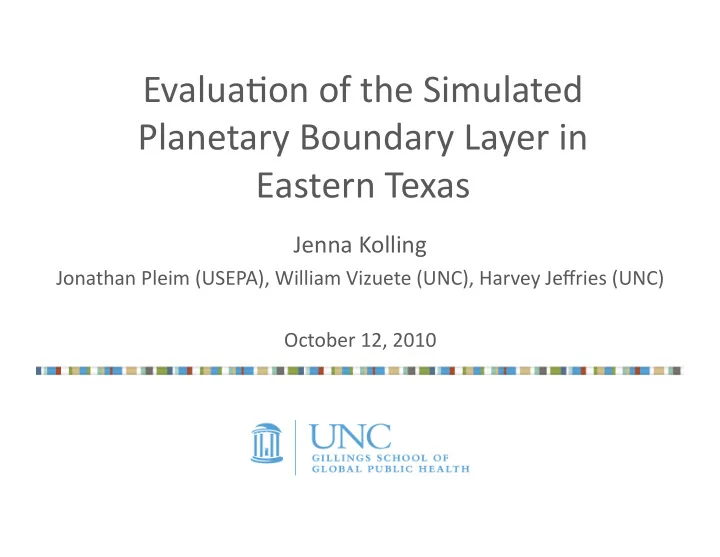

Evalua&on of the Simulated Planetary Boundary Layer in Eastern Texas Jenna Kolling Jonathan Pleim (USEPA), William Vizuete (UNC), Harvey Jeffries (UNC) October 12, 2010
Research Objec&ves Evaluate two different methods for determining the height of the planetary boundary layer (PBL) in meteorological models. Test the Asymmetric Convec&ve Model, Version 2 (ACM2) PBL parameteriza&on scheme to see if it can represent convec&ve condi&ons more accurately than the Eta TKE scheme. Texas Nonattainment Areas Map – Ozone (8-hour) Source: US EPA Office of Air and Radiation
The Planetary Boundary Layer (PBL) Directly influenced by Earth’s surface Thickness is variable in &me and space, ranging from a few hundred meters to a few kilometers.
Influence of the PBL on Ozone PBL height defines the volume of air into which pollu&on from surface sources is well mixed. Ver&cal mixing within the PBL during the morning and early a[ernoon hours can have a variety of effects on ground level ozone concentra&ons. Rapid growth of the morning PBL: dilutes freshly emi]ed precursors at the ground level. leads to entrainment of aged pollutants from the free troposphere.
PBL Effects on Ozone Modeling in Eastern Texas MMV Height [O 3 ] and Production Pathways
Modeling the PBL The PBL height is computed in the meteorology model by the PBL parameteriza&on scheme, which determines the ver&cal structure of winds, temperature, and humidity. The large range of atmospheric turbulence scales present during convec&ve condi&ons makes it difficult to accurately predict the &ming and magnitude of the rise of the PBL. Previous PBL schemes are unable to resolve these turbulent scales of mo&on, e.g.: Local eddy diffusion schemes assume that all of the turbulence is sub‐grid. Simple non‐local closure models, represent only large‐scale transport driven by convec&ve plumes.
PBL Parameteriza&on Schemes Eta Turbulent kine&c energy scheme with local ver&cal mixing. Previous tests have shown insufficient mixing in the convec&ve boundary layer. ACM2 Combines both the local eddy diffusion and nonlocal closure components. Should be able to represent convec&ve condi&ons more accurately and thus more accurately predict the rise of the PBL.
Model Configura&on Episode Period: August 13, 2006 – October 11, 2006 Loca&on: Eastern Texas 4 km horizontal grid resolu&on Hourly PBL heights Model Types • Weather Research and Forecas&ng Model (WRF) ‐ V3.1 – PBL Scheme: ACM2 • Fi[h‐Genera&on NCAR Mesoscale Model (MM5) – V3 – PBL Scheme: Eta – Used for Houston Ozone A]ainment SIP
PBL Scheme Evalua&on Radar Wind Profilers (RWPs) Time‐height signal‐to‐noise ra&o data from the radar wind profilers were used to es&mate the hourly height of the day&me surface‐based mixed layer.
Results
Radar Wind Profiler Sites
Beaumont, Texas � Median PBL 2500 WRF Model MM5 Model 2000 Observed PBL Height (m) 1500 1000 500 0 7 8 9 10 11 12 13 14 15 16 17 18 19 Hour (CST)
Radar Wind Profiler Sites
Title
Radar Wind Profiler Sites
Title
Preliminary Findings For the 4km East Texas domain, WRF/ACM2 is able to predict much more accurate hourly median PBLs when compared to the MM5/Eta combina&on. The WRF/ACM2 model was much more accurate than the MM5/ Eta model at predic&ng the diurnal evolu&on of the PBL for the 7 inland sites in Eastern Texas. For the 3 sites located closest to the Gulf of Mexico, the WRF/ ACM2 model was more accurate at predic&ng the morning rise of the PBL, however it slightly over‐predicted the a[ernoon peak of the PBL.
Future Work Calculate the average error and mean bias for both Met/PBL combina&ons. Expand evalua&on to include more PBL height observa&ons taken during TexAQSII including PBLs measured from a ground‐ based Lidar and rawinsonde balloons launched several &mes a day. Look at specific days where PBL rose rapidly to evaluate PBL schemes during convec&ve condi&ons. Evaluate the use of WRF/ACM2 in CMAQ to see how PBL heights translate into MMVs and how ozone concentra&ons are affected.
Acknowledgements • William Vizuete, UNC (advisor) • Rob Gilliam, USEPA • Sonoma Technology, Inc. • Doug Boyer, TCEQ • Alex Valencia, IE • John‐Nielsen Gammon, TAMU • Modeling Air Quality Group @ UNC – Especially Harshal Parikh and Barron Henderson
Ques&ons?
Recommend
More recommend